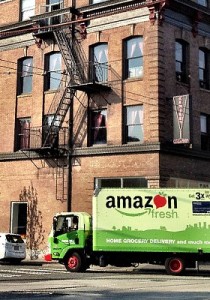 After testing for 6 years in Seattle, Amazon launched AmazonFresh in LA, which is the beginning of Amazon’s grocery expansion efforts to potentially all large metro areas in the coming years. The grocery category is a ~$600bn opportunity in the U.S., but Amazon’s strategy will likely target the top 20 metro areas (MSAs) by population, which we estimate is a $220bn opportunity.
After testing for 6 years in Seattle, Amazon launched AmazonFresh in LA, which is the beginning of Amazon’s grocery expansion efforts to potentially all large metro areas in the coming years. The grocery category is a ~$600bn opportunity in the U.S., but Amazon’s strategy will likely target the top 20 metro areas (MSAs) by population, which we estimate is a $220bn opportunity.
Some of the Attributes to AmazonFresh that may differentiate it from its competitors and diminish the negative impact of AmazonFresh include – charging fees ($7.99-$9.99 per deliver below $100), Amazon Prime Fresh program (high $299 upfront fee), opportunity to sell non-grocery products that have higher margins, third party marketplace and AmazonFresh may target a higher income customer.
In L.A. (which also appears to be in test mode), AmazonFresh is available with a 90 day free trial of Prime and, upon completion, has a $299 annual fee for free delivery for orders over $35. The average number of grocery trips per week is 2.2 (per FMI), which would imply a cost at $2.62 per delivery, but Amazon’s minimum free-order threshold of $35 is higher than the avg. supermarket sale of $27.30 in 2011, which could limit orders. We expect Amazon to operate its grocery business near breakeven to drive PrimeFresh adoption.
It appears Safeway and Kroger would be exposed to additional competition in Seattle and L.A. given their significant market share in those markets. Amazon is targeting the higher-income consumer and believe the impact of Amazon’s more aggressive push into the grocery space will have limited impact on traditional supermarkets (such as Kroger and Safeway) and Walmart, but the competitive threat to higher-income, convenience oriented food retailers (such as The Fresh Market and Whole Foods) bears monitoring longer-term.